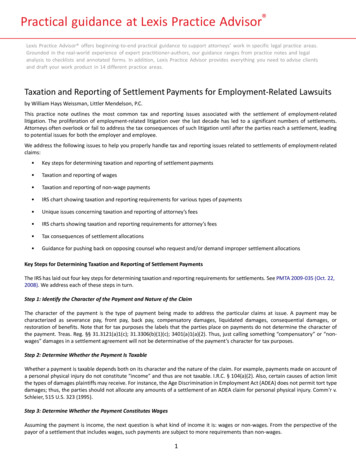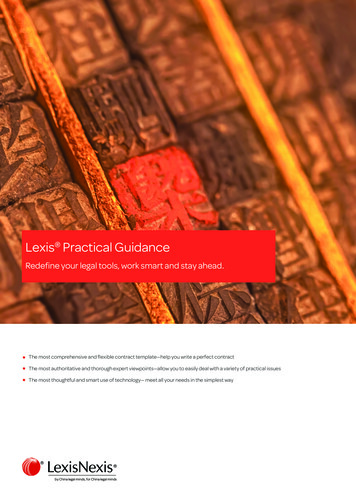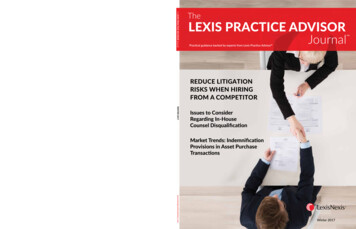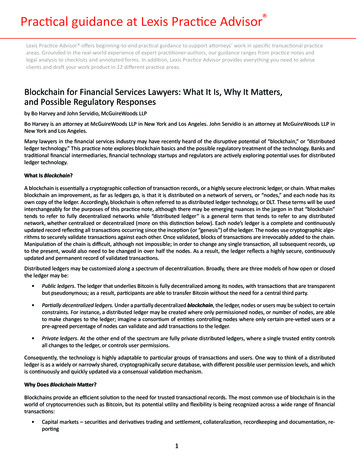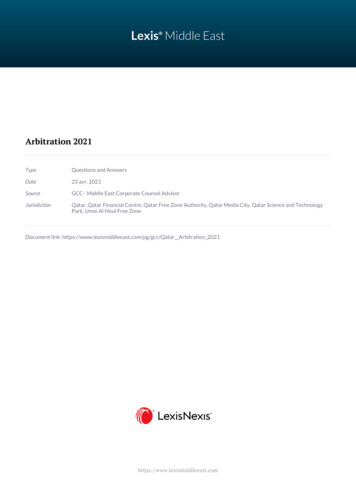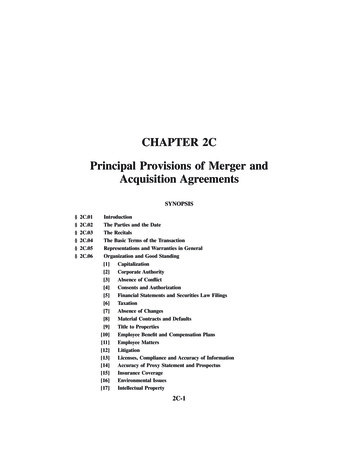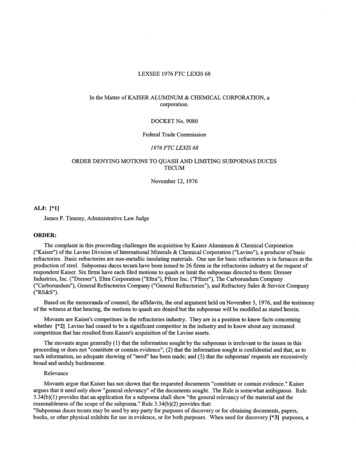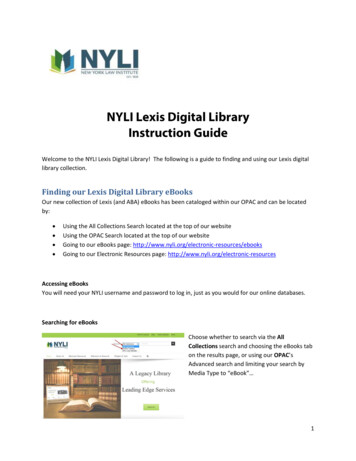
Transcription
Practical guidance at Lexis Practice Advisor Lexis Practice Advisor offers beginning-to-end practical guidance to support attorneys’ work in specific legal practice areas.Grounded in the real-world experience of expert practitioner-authors, our guidance ranges from practice notes and legalanalysis to checklists and annotated forms. In addition, Lexis Practice Advisor provides everything you need to advise clientsand draft your work product in 16 different practice areas.Investment Adviser Change of Control Transactions: Obtaining Client Consentby David W. Blass, Rajib Chanda and Samuel Francis, Simpson Thacher & Bartlett LLPThis practice note addresses adviser-assignment and client-consent issues in the context of private funds and separately managedaccounts. This practice note also identifies related considerations when structuring, negotiating, and closing transactions involvingthe change of control of an investment advisory business.IntroductionPer Section 205 (15 U.S.C. § 80b-5) of the Investment Advisers Act of 1940 (the Advisers Act), advisory contracts entered into byinvestment advisers registered with the Securities and Exchange Commission (SEC) may not be assigned without the client’s consent.Transactions involving an adviser, or a company that owns a stake in an adviser, often raise the issue of whether the transaction willresult in the assignment of advisory contracts. If an assignment results, what is the process an adviser will use to obtain the requisiteclient consent?Though outside the scope of this practice note, practitioners should keep in mind that a somewhat different regulatory frameworkapplies to the assignment of an advisory contract with a registered investment company. Specifically, Section 15 (15 U.S.C. § 80a-15)of the Investment Company Act of 1940 (the Company Act) requires an advisory contract with a registered investment companyto provide for the contract’s automatic termination in the event of its assignment and also requires shareholder approval for newadvisory contracts.Transactions Deemed an AssignmentSection 202(a)(1) (15 U.S.C. § 80b-2) of the Advisers Act defines the term “assignment” to include any direct or indirect transfer of anadvisory contract by an adviser or any transfer of a controlling block of an adviser’s outstanding voting securities. Control for thesepurposes means the power to exercise a controlling influence over the management or policies of a company, unless such power issolely the result of an official position with such company. Any person who beneficially owns, directly or indirectly, more than 25%of the voting securities of a company is generally presumed to control that company. However, a transaction that does not result in achange of actual control or management of the adviser would not be an assignment.The Advisers Act does not expressly provide a specific test for control, but practitioners generally apply the rebuttable presumptionin Section 2(a)(9) (15 U.S.C. § 80a-2) of the Company Act for purposes of determining whether a transaction is an assignment underthe Advisers Act. The SEC has also incorporated this presumption into the definition of control in the Glossary to Form ADV. Theformulations differ slightly in that the Company Act states “more than 25 percent” is presumed control, while the Form ADV standardis “25 percent or more.” This distinction can be significant where there is a change of ownership of exactly 25% of an adviser (e.g.,one of four equal partners is selling its interest).The SEC staff has discontinued its practice from the 1990s of issuing no-action letters addressing whether certain transactionsconstitute a change of control and thus an assignment under the Advisers Act. Parties contemplating the potential change of controlof an adviser therefore need to evaluate the relevant facts and circumstances in light of that earlier guidance and determine withtheir respective counsel whether such transaction could be deemed an assignment.Consequences for Failing to Obtain ConsentThe primary consequence for assigning an advisory contract without the client’s consent is a claim for breach of contract. Clients mayseek to bring a lawsuit against the adviser asserting a state law contract claim or, potentially, under the limited private right of actionimplied by Section 215 (15 U.S.C. § 80b-15) of the Advisers Act to void the contract and obtain restitution of advisory fees paid. Whilethere have not been many cases where a client sued an adviser for not obtaining the requisite consent as a stand-alone issue, sucha claim has been added to litigation involving other more egregious alleged actions. Proving the elements of reliance, causation, anddamages could be challenging (particularly if the client received notice), but there may be circumstances in which a client would havesuffered adverse consequences if the advisory relationship were terminated at the time of the transaction.1
Practical guidance at Lexis Practice Advisor For its part, the SEC has expressed the view that its enforcement authority extends only to the requirement in Section 205 (15 U.S.C.§ 80b-5) of the Advisers Act that the advisory contract contain the required consent provision. Significantly, the SEC does not believeit has the authority to bring an enforcement action against an adviser solely for failing to obtain the consent. The SEC’s view of itsauthority has changed over the years. In the past, the SEC asserted that it had the authority to bring an enforcement action against anadviser both for its omission of the required anti-assignment provision in an advisory contract and for its failure to obtain the consentthis provision requires.That said, if the SEC were motivated to bring an action against an adviser, it could seek to assert authority other than Section 205(15 U.S.C. § 80b-5) for the basis of the action. For example, the SEC potentially could assert that an adviser’s breach of the terms ofits advisory contracts is a violation of its fiduciary duties under Section 206(1) or (2) (15 U.S.C. § 80b-6) of the Advisers Act (the antifraud provisions) or a failure to implement controls mandated by Rule 206(4)-7 (17 C.F.R. § 275.206(4)-7) under the Advisers Act (thecompliance rule).Interpretation of Advisory ContractsWhen a transaction constitutes an assignment under the Advisers Act, each advisory contract may establish a specific process forobtaining the client’s consent, as well as other rights the client has if the adviser breaches the agreement. A transaction that does notresult in a change of actual control or management of the adviser within the meaning of the Advisers Act may nevertheless breachthe contract’s express anti-assignment provision.Applicable state law, including statutes regarding mergers and acquisitions and relevant case law, generally governs these provisions.Certain deal structures, such as reverse triangular mergers and indirect stock acquisitions, are more likely to avoid anti-assignmentprovisions effectively because the adviser survives the transaction and remains the same legal entity as the original party to itscontracts. Courts typically analyze the language of such provisions in determining whether the parties intended to prohibit such formof change of control, and the use of comprehensive anti-assignment language may be a deciding factor.Notice and Consent ProcessThe Advisers Act and SEC guidance do not expound on appropriate language for, or the interpretation of, the required contractualprovision that the advisory contract may not be assigned without the consent of the other party to the contract. As a result, someimportant questions are left to interpretation, including who is authorized to give consent on behalf of clients, whether affirmativeconsent is required or if negative consent is sufficient, how many days in advance of a transaction must clients be notified, andwhether such notices need to be delivered to clients in any specific way.Who Can Provide Consent on Behalf of Clients?Section 205 (15 U.S.C. § 80b-5) states that the “other party to the contract” must consent to the assignment. In the case of amanaged account or single-investor fund, the adviser would request consent from the sole investor. For investment platforms such ascollective-investment trusts, wrap-fee programs, and insurance-dedicated funds, the trustee or sponsor is often authorized to provideconsent on behalf of the underlying investors. Similarly, where an offshore pooled-investment vehicle is governed by an independentboard of directors that can objectively assess the transaction, the board’s consent could be sufficient.Practices diverge, however, with respect to obtaining consent from a domestic private fund with no board of directors. The expedientview is that the general partner / managing member is authorized to provide consent on behalf of the fund. However, there may bea conflict of interest if the general partner / managing member is an affiliate of the adviser, as is typically the case. The more typicalapproach is therefore to notify and request consent from the underlying investors. The adviser may offer each investor an opportunityto withdraw from the fund (in the case of an open-end fund) or engage a third-party expert to represent the investors’ interests, seekconsent of a group authorized to act on behalf of investors (such as a limited-partner advisory committee), and/or hold a vote of theinvestors to approve the assignment (in the case of a closed-end fund). The SEC has likewise implied in recently settled enforcementactions that a committee of independent investors may provide consent, but not a related person of the adviser.What Form of Consent Must Be Obtained?The parties must also determine the proper form of consent to request from each client, including whether such consent should beaffirmative or negative. An adviser could obtain affirmative consent by providing notice of the proposed transaction to its clients andasking them to sign and return a written consent. Given the logistical difficulties with obtaining affirmative consents, the SEC in aseries of no-action letters in the 1980s approved a negative consent process in which a client’s inaction may be treated as consent.The instructions to Item 5 of Form ADV-W indeed provide that “Client consent can be obtained through an actual consent, or can beinferred through the use of a negative consent.”2
Practical guidance at Lexis Practice Advisor Whether an adviser can rely on negative consent or is required to obtain affirmative consent generally depends on the terms of theadvisory contract with each client and state law. Affirmative consent is likely required if the contract specifies that it may not beassigned without “written” or “express” consent, whereas negative consent would be acceptable if the contract explicitly permitsnegative consent or may be sufficient if the contract is silent as to the requisite form of consent. Thus, the particular form of consentthat is required is largely agreed-upon contractually between the adviser and its client.When Should an Adviser Request Consent?The form of consent will generally dictate the notice period required for the assignment of a client’s advisory contract. Affirmativeconsent doesn’t necessarily demand any specific period of time, but it could actually take many months to receive a formal responsefrom certain clients, particularly governmental and other institutional investors. Conversely, clients must be given adequate notice ifthe adviser is relying on negative consent, and the SEC has commented only on consent periods of at least 45 to 60 days (although anotice period of 30 days is occasionally used in practice).Putting these timelines into practice, an adviser could obtain negative consent by notifying its clients, for example, 20 days priorto the transaction and, if a client has not responded within such period, the adviser would continue to provide advisory services,subject to the client’s right to object within a second period of 45 days by written notice to the adviser (or other affirmative denial).Alternatively, the adviser could send a second notice to each client that has not responded, stating that the adviser will continue toprovide advisory services, subject to the client’s right to object within 45 days after such second notice. In either case, if the clientdoes not terminate the adviser’s services within such period, the adviser can presume that the client consents to the assignment.How Should an Adviser Deliver Consent Notices?Business contracts typically contain a notice provision that sets forth the manner in which the parties may deliver information to eachother during the term of the contract. Advisory contracts may likewise specify the acceptable methods of delivery, such as personaldelivery, courier service, registered or certified mail, facsimile, and/or e-mail. This provision might also address the form the noticeshould take, when notice is considered to be effective, who must receive the notice, and how changes to the contact informationshould be communicated.Given that notice provisions in the advisory contracts with different clients may vary, the parties may opt for using a uniform deliverymethod, such as sending copies of the notice to all clients via facsimile and/or e-mail, and then follow up by sending the originalnotice to each client in the manner prescribed in the applicable advisory contract. In addition, particularly if the parties are relying onnegative consent, the adviser should consider requesting some sort of confirmation to ensure that each client has received the notice,such as a physical or electronic return receipt.Deal-Related ConsiderationsThe ability to assign advisory contracts in accordance with applicable laws is a fundamental concern, along with tax, liability, andother considerations in all phases of an investment adviser M&A deal. The parties should begin probing any consent issues earlyon in the due-diligence stage of the proposed transaction, continue to work out the parameters and ramifications for notifying andrequesting consent from each of the clients in the purchase agreement and/or other transaction documents, and then take suchactions as are necessary after signing and closing to carry out the agreed process.Conducting Due DiligenceAs with any M&A transaction, the buyer should carefully examine the seller’s organizational and ownership structure, business strategiesand products, material contracts and counterparty relationships, litigation and regulatory compliance, executive compensation andemployee benefits, real estate, intellectual property, and so on. With respect to consent in particular, the organizational and operatingagreements of the corporate entities as well as the advisory contracts and other offering documents and investor side letters relatingto the clients may provide various contractual rights and obligations relevant to an assignment transaction.The parties should review these documents governing both the seller’s corporate entities as well as the clients they manage. Theformer may consist of the investment adviser, broker-dealer, general partner, managing member, and any other operating and holdingentities at the top of the seller’s corporate structure. The latter would include all types of funds and accounts sponsored and/ormanaged by the adviser, such as private investments funds, registered investment companies, single-investor vehicles, separatelymanaged accounts, sub-advised funds and accounts, investment trusts, wrap fee programs, and any other investment entities andtrading vehicles in the structure below.3
Practical guidance at Lexis Practice Advisor A practitioner should review the documents for at least three issues: Type of consent. These documents usually have provisions regarding an assignment of the contract that set forth whether andwhat type of consent is required from the other parties. Form and timing. If not specifically addressed in the assignment section, notice provisions may also determine the requiredrecipient, form, timing, and/or delivery of any notices and consents provided under the contract. Notice requirements / key person. These documents may also have separate provisions that require notice or consent withrespect to a change of control of the entity and/or any “key person” event that could be triggered in connection with suchtransactions, and that could potentially give rise to a different set of rights and obligations.Negotiating Definitive AgreementsThe consent process may be addressed by the parties in a number of sections of the purchase agreement. In addition to standardrepresentations and warranties, the agreement should contain a representation that the seller has provided all advisory contractsand other relevant adviser and fund documents, which may be listed in an attached schedule. The agreement or schedule couldalso specify the type and form of consent required for each client. To the extent that the seller is not able to provide the relevantdocuments with respect to any clients for whatever reason, the seller may be asked to represent the type of consents required withrespect to such clients.In addition to the representations above, the purchase agreement may also include a covenant that the seller will use its best efforts,with the buyer’s cooperation, to deliver the notices and obtain the requisite consents in accordance with the process specified foreach client. Depending on business considerations and the agreed-upon consent process, the buyer might also ask to be indemnifiedfor any damages resulting from the consent process and/or the failure to obtain the consent of any client in connection with thetransaction.The purchase price and conditions to closing may be tied to these representations and covenants regarding client consents. Paymentof the purchase price is sometimes spread over a period of time, with adjustments based on various factors, such as the performanceof the business over a number of years. Similarly, the purchase price could be adjusted based on the retention of clients underthe agreed-upon consent process. The parties may also agree on closing conditions relating to the receipt of consents from clientsrepresenting a specified percentage of assets under management and/or a certain number of the largest clients.Completing the TransactionThe notice and consent letters sent to clients might describe the proposed transaction in colloquial terms but will not necessarilycontain detailed disclosures. Rather, Part 1 of the seller’s Form ADV will be amended in connection with the transaction to reflectthe change of ownership and other technical changes, and the Part 2 brochure will likely need updated disclosures relating to theintegration of its business with the buyer. For example, there may be additional risks and conflicts to include as a result of thetransaction.The seller may also need to modify its compliance and other policies and procedures to align with the buyer’s. For instance, bothparties should consider implications concerning their current holdings as well as any future opportunities in regard to trade allocationand investment limitations. The governing documents for funds managed by the either of the parties may provide that certainapprovals and/or notifications are required when a fund or account makes or disposes of an investment in which another fund oraccount has a position above a certain threshold or when making certain types of investments other than through particular fundsor accounts.Client notification and/or consent may also be required to the extent the parties wish to amend any provisions of the advisoryagreements or other governing documents. Making amendments could be particularly challenging where negative consent is usedbecause contracts often provide that they may only be amended in a writing signed by the parties. In such cases, the parties couldeither request a signed writing as part of the consent process or instead pursue any such amendments following the transaction. Theparties could also work together after closing to develop updated forms for any new funds and accounts going forward consistentwith terms and disclosures in the buyer’s offering documents.4
Practical guidance at Lexis Practice Advisor ConclusionWhen considering a potential change of control, an SEC-registered investment adviser should determine whether the proposedtransaction would be deemed an assignment under the Advisers Act and how to obtain client consents in accordance with the termsof the applicable advisory contracts. The adviser will likely need to ascertain the required recipient, form, timing, and delivery ofany notices and consents with respect to each of its clients. The parties should therefore discuss any issues relating to notices andconsents, then work out a detailed plan in the transaction documents, and finally execute the agreed process upon signing andclosing.Related ContentFor additional information on manager matters, consent, and changes of control, see the following practice notes and forms: Drafting a Management Agreement for a Private Equity Fund Domestic Transfer Agreement and PSA Limited Partner Transfers and Secondary Sales Investor Remedies Side Letter for a Private Equity Fund Drafting a Side Letter for a Private Equity FundThis excerpt from Lexis Practice Advisor , a comprehensive practical guidance resource providing insight from leading practitioners, is reproduced with thepermission of LexisNexis. Lexis Practice Advisor includes coverage of the topics critical to attorneys who handle legal matters. For more informationor to sign up for a free trial visit www.lexisnexis.com/practice-advisor. Reproduction of this material, in any form, is specifically prohibited without writtenconsent from LexisNexis.Learn more at: lexisnexis.com/practice-advisorLexisNexis, Lexis Practice Advisor and the Knowledge Burst logo are registered trademarks of Reed Elsevier Properties Inc., used under license. 2017 LexisNexis. All rights reserved.5
Practical guidance at Lexis Practice Advisor 2 For its part, the SEC has expressed the view that its enforcement authority extends only to the requirement in Section 205 (15 U.S.C.

